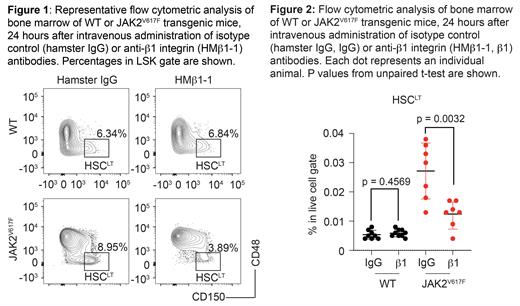The major barrier to progress in treatment of primary myelofibrosis (PMF) is the lack of effective therapies targeting the malignant JAK2 V617F hematopoietic stem cell (HSC), the source of disease progression and relapse. Expression of JAK2 V617F induces abnormal proliferation and differentiation of HSC, affecting all blood lineages but most prominently the erythro-megakaryocytic lineage, leading to clonal megakaryocyte proliferation, erythrocytosis and thrombocytosis.
In our previously published work ( Matsuura et al, Blood 2020) we identified elevated expression of the α5 subunit of the α5β1 integrin receptor as a driver of JAK2 V617F megakaryocyte proliferation. Expression of β1 integrin subunit was similar in wild-type (WT) and JAK2 V617F megakaryocytes, but activation of β1 integrin, detected by the conformation-specific 9EG7 antibody, was elevated in JAK2 V617F megakaryocytes. Following up on those findings, we detected elevated β1 integrin activation in long-term hematopoietic stem cells (HSC LT, LSKCD48-CD150+) from JAK2 V617F transgenic mice ( Xing et al, Blood 2008) when compared to WT controls.
To determine whether inhibition of β1 integrin in vivo reduces the number of HSC LT in JAK2 V617F transgenic mice, we examined HSC LT 24 hours after intravenous administration of 2mg/Kg of anti-β1 integrin inhibitory antibody HMβ1-1. This regimen led to a sharp reduction in number and percentage of HSC LT in JAK2 V617F transgenic mice, to 45% of control antibody-treated animals. The effect on WT HSC LT was negligible. HSC ST (LSKCD48-CD150-) and MPP2 (LSKCD48+CD150+) were also reduced, but the reduction was not statistically significant. MPP3/4 (LSKCD48+CD150-) and LSK were not affected. Megakaryocyte progenitors (LKCD41+CD150+) were significantly reduced. Inhibition of β1 integrin also sharply reduced peripheral blood platelet numbers in WT animals. The reduction in JAK2 V617F transgenic mice was not statistically significant. A longer observation time of 7 days demonstrated that while WT animals were able to mount a robust regenerative response with slight but significant increases in HSC LT and normalization of platelet numbers, in JAK2 V617F transgenic mice the number of HSC LT remained depressed, as did downstream stem/progenitor populations at various significance levels.
To gain insight into the mechanisms that lead to reduction in HSC LT, we examined apoptosis, cell cycle and HSC mobilization, all processes known to be affected by β1 integrin. Although basal expression of the apoptotic marker annexin V was decreased in JAK2 V617F HSC LT compared to WT, no differences were detected upon administration of HMβ1-1 in both genotypes at 4 hours post-administration. Similarly, peripheral blood colony assays revealed a basally higher level of stem/progenitor mobilization in JAK2 V617F, which did not significantly increase upon HMβ1-1 administration. In contrast, the cell cycle profile, examined at 4 hours post-administration to account for the earliest effects, demonstrated a decrease in G0 phase cells and increase in S/G2/M cells indicating cell cycle induction and exit from quiescence in both WT and JAK2 V617F HSC LT. The results indicate that inhibition of β1 integrin disrupts the adhesion-mediated cell cycle suppression in both WT and JAK2 V617F HSC LT leading to exit from quiescence. However, the downstream consequences of cell division in HSC LT differ significantly, with an apparent loss of regenerative potential in JAK2 V617F HSC LT, at least at the observed timepoints. Longer observation times are required to determine whether continuous β1 integrin inhibition can lead to JAK2 V617F HSC LT exhaustion. More sensitive assays to monitor mobilization are warranted to quantify possible minute amounts of mobilized HSC LT.
Our preclinical studies indicate that β1 integrin is an attractive target to specifically reduce the number of JAK2 V617F HSC LTin vivo. The role of β1 integrin in HSC LT has not been thoroughly studied due to lack of phenotype in β1 integrin-deficient HSC ( Brakebush et al, Immunity 2002). Our studies using the anti-β1 integrin antibody in WT HSC LT confirm previous findings. However, β1 integrin seems to be critical for maintenance of JAK2 V617F HSC LT, offering a possible therapeutic window. Understanding how β1 integrin supports quiescence in HSC LT will bring us a step closer to understanding the mechanisms that drive malignancy and fitness in JAK2 V617F HSC LT.
Disclosures
No relevant conflicts of interest to declare.


This feature is available to Subscribers Only
Sign In or Create an Account Close Modal